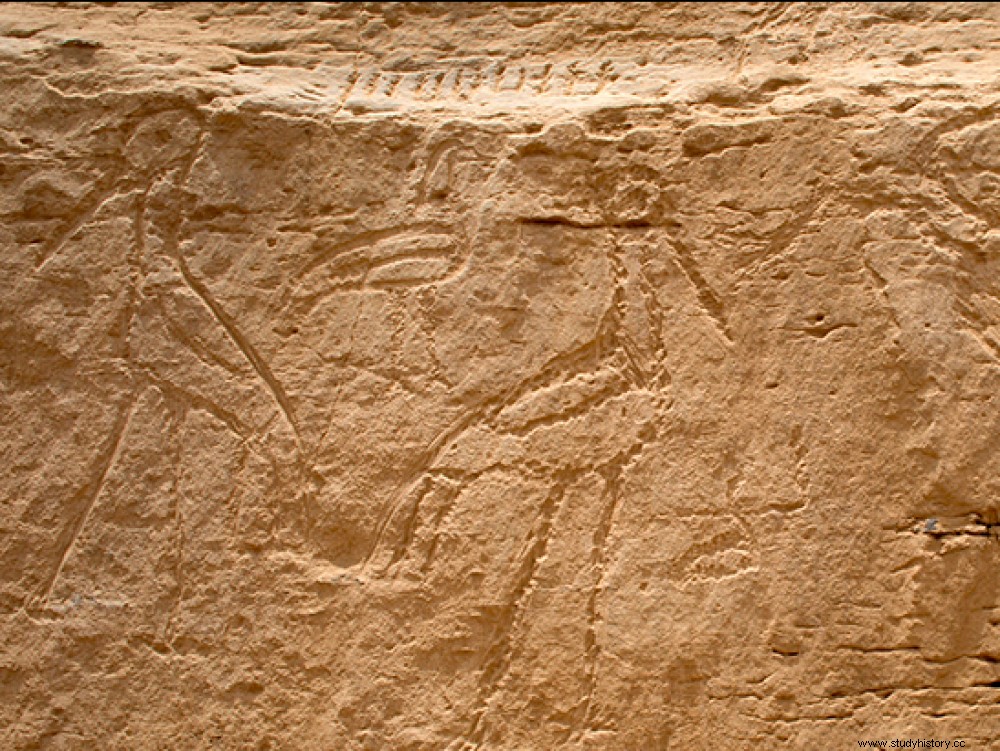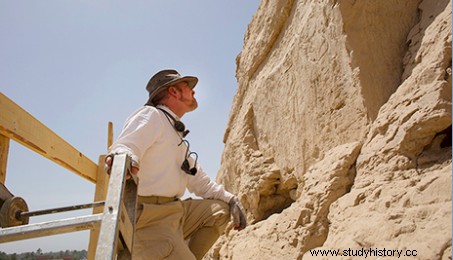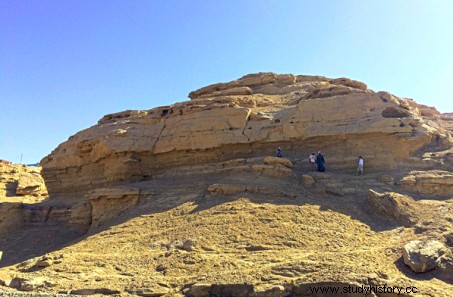Researchers have made an exceptional discovery south of Luxor:a rock wall covered with proto-hieroglyphs, which prefigure the writing of the ancient Egyptians.

On the cliff of the site of Al-Khawi, appear, among others, two storks back to back and a bald ibis bird above.
EGYPTOLOGY. They offered themselves to the incandescent rays of the solar star for nearly 5250 years... Exceptional proto-hieroglyphs and multiple rock inscriptions have been unearthed, engraved on sandstone cliffs near the village of Al-Khawi in 60 km south of Luxor, Egypt. “A sensational discovery ”, did not hesitate to comment on the French Egyptologist Pascal Vernus, director emeritus at the École Pratique des Hautes Etudes (EPHE), joined in Bonn (Germany), where he was taking part in a colloquium precisely devoted… to writing in the Nile Valley.
Specialists from Yale University (United States), the Ministry of Egyptian Antiquities and the Royal Museums of Art and History of Brussels (Belgium) have indeed revealed that they have discovered within the framework of the Elkab Desert Survey Project several inscriptions among which imposing animal figures that would date back to predynastic periods, and therefore to the origins of the fascinating and poetic writing system of ancient Egypt.

John Coleman Darnell, Egyptologist at Yale University (United States) examines the proto-hieroglyphics found at the top of the cliff. © Ministry of Egyptian Antiquities/Yale University
The first stages of “the writing of the gods”
For John Coleman Darnell, of Yale University, the head of the research, these figures would constitute “some of the first stages of hieroglyphic writing” . Indeed, “if it is not yet a question of writing in the proper sense of the term, we are faced with a painting implementing symbols which will later become signs of writing during the pharaonic period. ”, says Pascal Vernus. Thus, incised on the wall, we can see a bull's head and especially a species of large stork, (jabiru) which later became “a hieroglyph translating the Egyptian notion of ba, the capacity for a being to manifest itself in different forms” , continues the expert. Among the other figures, a bald ibis (Geronticus eremita ), bird whose hieroglyph will express the notion of akh , a transfiguration allowing the deceased to live in the afterlife. Engraved back to back, the two birds carved into the huge rock wall represent above all a well-known theme in Pharaonic Egypt:that of the symbol of departure and arrival of the course of the sun, a role which would later rather devolve to bulls or lions. “The two jabirus birds respectively symbolize the manifestation of the sun which rises in the east, crosses the sky, then ends its journey by setting in the west, thus becoming a nocturnal sun ”, says Pascal Vernus.
Very sophisticated symbolism
The discoverers thus place the graphic composition found on these cliffs around 3250 BC, that is to say 250 years before the advent of the pharaonic state with the unification of Egypt by the sovereign Narmer (around 3000 BC). Above all, this "table" shows that before the first assured attestations of Egyptian writing — that which appeared under the immediate predecessors of King Nârmer, around 3100 BC — the Egyptians had developed a very sophisticated symbolism which already contained the seeds of this writing system. “This symbolism is also attested in a related way on the labels ( inscriptions) of the wine jars found in the famous tomb U-j of Abydos ( read the report "Egypt of the Scorpion Kings", Sciences et Avenir n° 711), roughly contemporary with the painting which has just been found ”, adds the Egyptologist.

General view of the hieroglyphic cliff near Al-Khawi, 60 kilometers south of Luxor. © Ministry of Egyptian Antiquities/Yale University
As for the exceptional dimensions of the signs making up this painting (about 60 cm high), they would be the manifestation of a well-established trend during the Pharaonic period:"the interpretations that ideology gave to the world were often displayed in a formal pageantry and locations making them particularly conspicuous and visible", as here these cliffs located along a very busy route between the two great cities of Elkab, the ancient Nekheb, and Hierakonpolis. We also think of the border stelae that the pharaohs erected at the limits of their territory, or even of the decrees, such as that of Nauri, found engraved on the wall of a rocky hillock north of Dongola, in Nubia. These inscriptions from the Elkab desert thus reflect an important transitional phase in the history of ancient Egyptian thought and what would become “the writing of the gods”.
